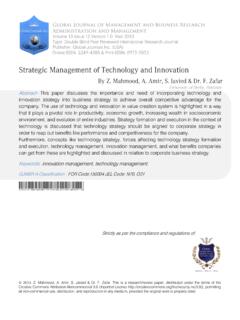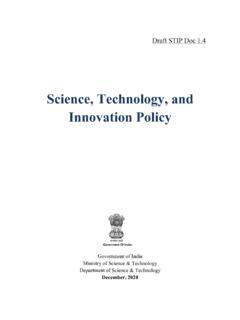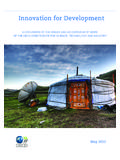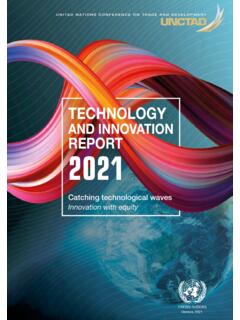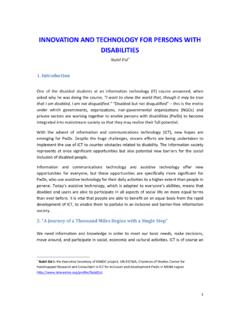Transcription of Handbook of Technology and Innovation Management
1 Handbook of Technologyand Innovation ManagementEdited byScott ShaneCase Western Reserve UniversityA John Wiley and Sons, Ltd., PublicationContentsPrefaceixList of ContributorsxiEditor s IntroductionxvPart I The Evolution of Technology , Markets, and Industry11 Technology and Industry Evolution3 Rajshree Agarwal and Mary Tripsas2 The Evolution of Markets: Innovation Adoption, Diffusion, MarketGrowth, New Product Entry, and Competitor Responses57 Venkatesh ShankarPart II The Development and Introduction of New Products1133 Understanding Customer Needs115 Barry L. Bayus4 Product Development as a Problem-solving Process143 Christian Terwiesch5 Managing the Unmanageables of Sustained Product Innovation173 Deborah DoughertyviCONTENTSPart III The Management and Organization of Innovation1956 Rival Interpretations of Balancing Exploration and Exploitation:Simultaneous or Sequential?
2 197 Eric L. Chen and Riitta Katila7 R&D Project Selection and Portfolio Management : A Review of the Past,a Description of the Present, and a Sketch of the Future215D. Brunner, L. Fleming, A. MacCormack, and D. Zinner8 Managing the Innovative Performance of Technical Professionals239 Ralph KatzPart IV Technology Strategy2659 The Economics and Strategy of Standards and Standardization267 Shane Greenstein and Victor Stango10 Intellectual Property and Innovation295 Rosemarie H. Ziedonis11 Orchestrating Appropriability: Towards an Endogenous Viewof Capturing Value from Innovation Investments335 Henry Chesbrough12 Individual Collaborations, Strategic Alliances and Innovation :Insights from the Biotechnology Industry353 Paul Almeida, Jan Hohberger, and Pedro ParadaPart V Who Innovates?
3 36513 Technology -Based Entrepreneurship367 David H. Hsu14 Knowledge Spillover Entrepreneurship and Innovation in Largeand Small Firms389 David B. AudretschCONTENTSvii15 The Financing of Innovation409 Bronwyn H. Hall16 The Contribution of Public Entities to Innovation and TechnologicalChange431 Maryann P. Feldman and Dieter F. KoglerIndex461 PrefaceWhen Rosemary Nixon, an editor for Blackwell Publishing, now part of JohnWiley & Sons, approached me in 2003 to edit aHandbook on the Management ofTechnological Innovation , I quickly agreed. The field of Management of technologyhad undergone major changes in the previous two decades, with an increased focuson Technology strategy, entrepreneurship, and product development, and I thoughtthat the time was right for a Handbook that provided some order to the plethora ofnew arguments and findings.
4 Moreover, many of the names associated with cuttingedge research in this area were not leading scholars two decades earlier frankly,many of them were not even scholars 20, or even 10, years before. And I thoughtthat a book that collected their views and summaries of the field would be extremelyuseful to current scholars and students. Finally, I thought that it would be easyto put together this Handbook and that it would be published within a I should have thought a little more about this undertaking before agreeingto do it. Instead of taking one year, it has taken closer to five years. Unfortunately, welost several authors due to personal issues and had to replace them with others, whichupturned all plans to get the Handbook out quickly.
5 However, with the manuscriptnow complete, I can reflect upon the effort and conclude that I was right aboutthe idea behind the book. The changes in the field demand this Handbook , andbringing together the work of the giants in the field will prove to be of value to bothcurrent and future scholars even if agreeing to edit this Handbook was probably abad idea need to offer my thanks to the authors of the chapters of this Handbook and tomy editor, Rosemary Nixon, and the staff at Blackwell Publishing and John Wiley &Sons for their extraordinary patience and flexibility. You are all better people thanme. I probably would not have tolerated the delays in the development of this bookwith the grace that all of you would also like to offer my thanks to A.
6 Malachi Mixon III and the AT&TFoundation (formerly the SBC Foundation) for their financial support of myxPREFACE scholarly efforts since arriving at Case Western Reserve University. Without theirgenerosity this book would not have , I would like to thank my wife Lynne, daughter Hannah, and son of them helped me in their own ways. Hannah and Ryan helped by beingexcellent playmates when I needed breaks from this project, and Lynne helped meby encouraging and supporting my efforts to create this ShaneList of ContributorsRajshree AgarwalCollege of BusinessUniversity of Illinois at Urbana-ChampaignChampaign, IL AlmeidaMcDonough School of BusinessGeorgetown UniversityWashington, DC AudretschInstitute for Development StrategiesIndiana UniversityBloomington, IN L.
7 BayusKenan-Flagler Business SchoolUniversity of North CarolinaChapel Hill, NC BrunnerHarvard Business SchoolHarvard UniversityBoston, MA OF CONTRIBUTORSEric L. ChenDepartment of Management Science and EngineeringStanford UniversityStanford, CA ChesbroughHaas School of BusinessUniversity of California at BerkeleyBerkeley, CA DoughertyRutgers Business SchoolRutgers UniversityNewark, NJ P. FeldmanDepartment of Public PolicyUNC Chapel HillChapel Hill, NC FlemingHarvard Business SchoolHarvard UniversityBoston, MA GreensteinKellogg School of ManagementNorthwestern UniversityEvanston, IL HallDepartment of EconomicsUniversity of California at BerkeleyBerkeley, CA OF CONTRIBUTORS xiiiJan HohbergerDepartment of Business PolicyESADE Business School08034 Barcelona, HsuWharton School of BusinessUniversity of PennsylvaniaPhiladelphia, PA KatilaDepartment of Management Science and EngineeringStanford UniversityStanford, CA KatzCollege of Business AdministrationNortheastern UniversityBoston.
8 MA KoglerDepartment of GeographyUniversity of TorontoToronto, ON M5S MacCormackHarvard Business SchoolHarvard UniversityBoston, MA ParadaDepartment of Business PolicyESADE Business School08034 Barcelona, OF CONTRIBUTORSS cott ShaneWeatherhead School of ManagementCase Western Reserve UniversityCleveland, OH ShankarMays Business SchoolTexas A&M UniversityCollege Station, TX StangoTuck School of BusinessDartmouth CollegeHanover, NH TerwieschWharton School of BusinessUniversity of PennsylvaniaPhiladelphia, PA TripsasHarvard Business SchoolHarvard UniversityBoston, MA ZiedonisStephen M. Ross School of BusinessUniversity of MichiganAnn Arbor, MI ZinnerHarvard Business SchoolHarvard UniversityBoston, MA s IntroductionScott ShaneFor thousands of years, technological Innovation the application of knowledgeabout tools, materials, processes, and techniques to problem solving (Afuah,2003) has had a profound effect on our lives as people, sometimes positively,and other times negatively, as any user of electronic mail can attest.
9 Perhaps moreimportantly for the scholarly study of business, technological Innovation has been acentral component of the way in which new economic value is created by permittingpeople and companies to use existing resources more efficiently, as well as to comeup with products and services that meet people s needs in ways that were not metbefore (Mokyr, 1990).Because technological Innovation creates economic value, it also affects the growthand decline in shareholder wealth. This effect on shareholder wealth impacts allshareholders, regardless of whether they are founding entrepreneurs, employees,or investors in companies, and regardless of whether they are shareholders in theinnovating company or the company that competes with importance of technological Innovation to economic value creation andshareholder wealth has made the Management of it a central part of businessactivity.
10 Although technological Innovation can be accidental as well as planned,many firms seek to manage it in the hopes of making Innovation more profitable tothe firm. This effort to manage technological Innovation is important because, as thechapters in this Handbook point out, the Management of technological innovationdiffers from the Management of other aspects of business. Thus, an understandingof the Management of technological Innovation requires the development andtesting of novel , these theories do not just cover a narrow slice of business activity,but instead, need to explain a wide variety of business activities at a number ofdifferent levels of analysis.



